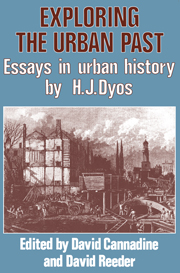Book contents
- Frontmatter
- Contents
- Acknowledgements
- Introduction: H. J. Dyos and the urban process, by David Reeder
- Part One The Urbanising World
- Part Two Transport and Urban Transformation
- 5 The objects of street improvement in Regency and early Victorian London
- 6 Workmen's fares in south London, 1860–1914
- 7 Railways and housing in Victorian London
- 8 Some social costs of railway-building in London
- Part Three The Urban Fabric
- Conclusion Urban history in the United Kingdom: the ‘Dyos phenomenon’ and after, by David Cannadine
- Appendix: A bibliography of the published writings of H. J. Dyos
- Notes
7 - Railways and housing in Victorian London
Published online by Cambridge University Press: 03 February 2010
- Frontmatter
- Contents
- Acknowledgements
- Introduction: H. J. Dyos and the urban process, by David Reeder
- Part One The Urbanising World
- Part Two Transport and Urban Transformation
- 5 The objects of street improvement in Regency and early Victorian London
- 6 Workmen's fares in south London, 1860–1914
- 7 Railways and housing in Victorian London
- 8 Some social costs of railway-building in London
- Part Three The Urban Fabric
- Conclusion Urban history in the United Kingdom: the ‘Dyos phenomenon’ and after, by David Cannadine
- Appendix: A bibliography of the published writings of H. J. Dyos
- Notes
Summary
Who builds? Who builds? Alas, ye poor!
If London day by day ‘improves’,
Where shall ye find a friendly door,
When every day a home removes?
The Builder, IX (1851), 395Show these men cottages in the country, such as I have supposed, readily accessible, and combined with an increase, not a diminution, of the other necessaries of life, and I am persuaded they would take advantage of them.
J.T. Danson: J. Stat. Soc, XXII (1859), 377The social history of Britain's railways is still largely unwritten. Yet it is probably true to say that railways had more radical consequences for the anatomy of the large mid-Victorian towns than any other single factor. Apart from increasing both their growth and prosperity, railways caused drastic changes in the configuration of many of their existing streets and in their internal communications. The changes they brought were not, however, confined to the physical layout of the urban landscape. Railways also influenced the daily lives of the townspeople themselves. It is the purpose of this essay to assess the impact which the building of railways had on one aspect of the lives of London workers a century ago, namely the condition and location of their homes. First, we shall examine the progress and extent of the housing demolitions which had to be made for new railways, and trace their immediate effects.
- Type
- Chapter
- Information
- Exploring the Urban PastEssays in Urban History by H. J. Dyos, pp. 101 - 118Publisher: Cambridge University PressPrint publication year: 1982

